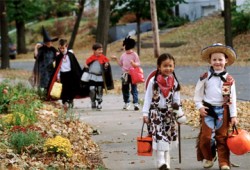 An estimated 40 million children between the ages of 5 and 14 could hit the trick-or-treat trails this Halloween according to the U.S. Census Bureau. The nation’s emergency physicians want all of them to enjoy the holiday traditions safely and not experience any Halloween horrors that would include spending time in the emergency department. Emergency physicians recommend that children “trick-or-treat” at organized Halloween festivities, such as local churches, shopping malls or schools. In addition, ACEP suggests that adults following tips for a safe and fun Halloween:
An estimated 40 million children between the ages of 5 and 14 could hit the trick-or-treat trails this Halloween according to the U.S. Census Bureau. The nation’s emergency physicians want all of them to enjoy the holiday traditions safely and not experience any Halloween horrors that would include spending time in the emergency department. Emergency physicians recommend that children “trick-or-treat” at organized Halloween festivities, such as local churches, shopping malls or schools. In addition, ACEP suggests that adults following tips for a safe and fun Halloween:
- Make sure your child stays on the sidewalks as much as possible (off streets) and obeys all traffic signals.
- Discuss the importance of staying together in a group. Require at least one adult to serve as chaperone during trick-or-treat gatherings.
- Make sure your child knows the potential dangers from strangers. Make sure they know never to accept rides from strangers or visit unfamiliar homes or areas.
- Avoid costumes that could cause children to trip, such as baggy pants, long hems, high heels and oversized shoes.
- Avoid costumes that obstruct the child’s sight or vision.
- Avoid masks if possible. If your child must wear one, make sure it is well ventilated.
- Make sure costume fabric, wigs and beards area made of flame-resistant materials, such as nylon or polyester.
- Keep candlelit Jack-O-Lanterns away from children so they can’t get burned or set on fire.
- Make sure costumes are visible at night: avoid dark colors. Add reflective tape to costumes so your child is more visible to motor vehicles.
- Make sure you see all of the candy before your child eats it. Avoid candy that is not wrapped in its original wrapper, as well as all fruit.
- Take a flashlight while trick-or-treating as visibility decreases long before it gets really dark.
- Check accessories such as swords, knives, wands and other pointed objects. Make sure they are made from flexible materials and have dulled edges.








